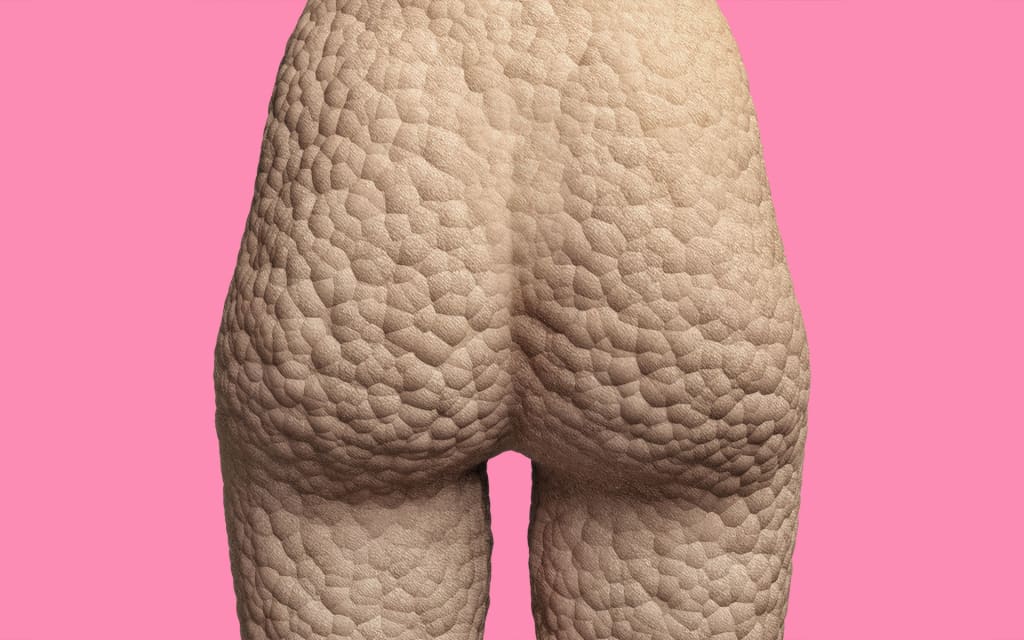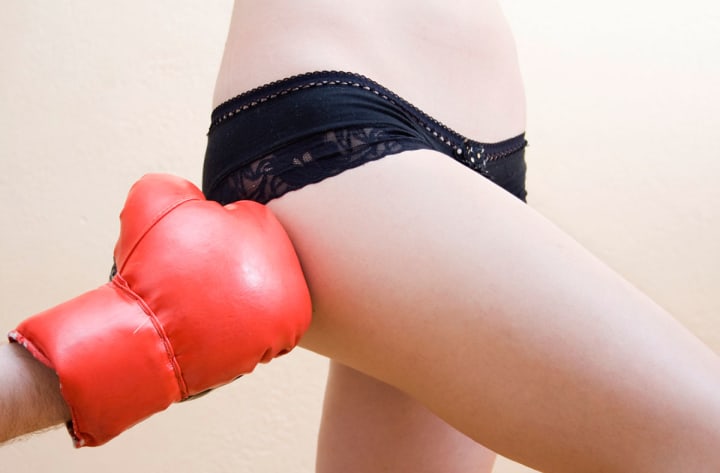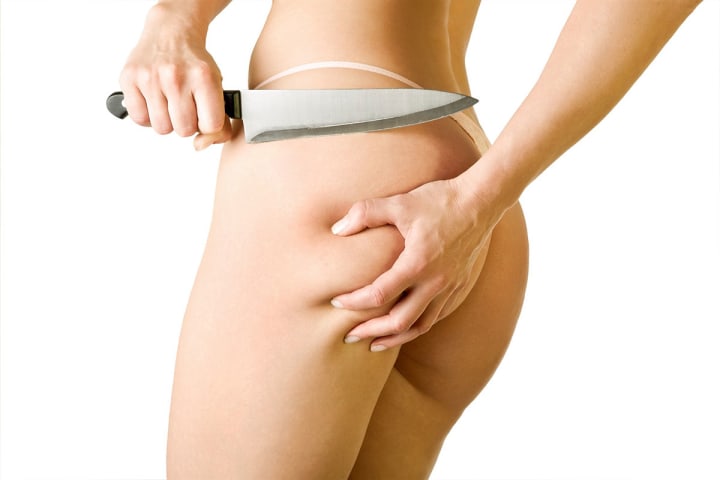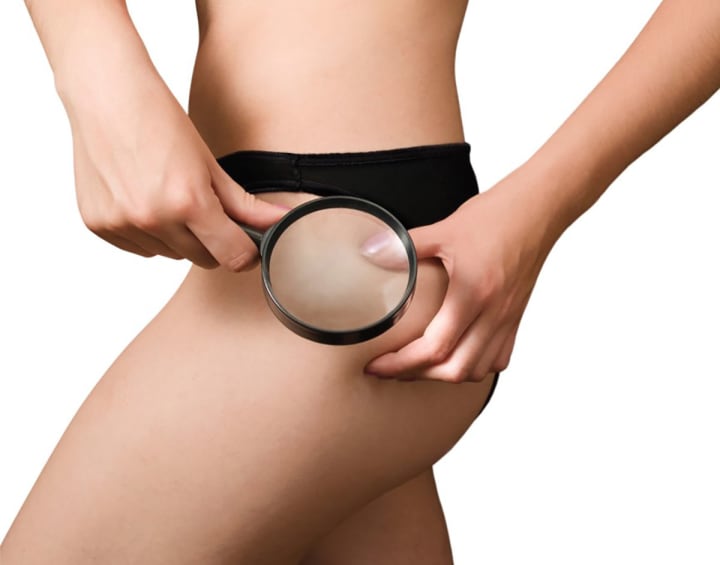What is Cellulite?
More important than 'what is cellulite?' is 'what to do with cellulite?'

“It" prefers females — blondes, brunettes, and redheads of all ages and sizes. Ninety percent of the women in the Western world have it, but nobody wants it. But what is cellulite? And more importantly, what can be done about cellulite? The French word for cellulite is fibrositis, an inflammation of the fibrous tissue.
How about you? Inspect your body under a strong light. The small shadows that you see indicate the problem spots. Or take a good-size piece of flesh between thumb and forefinger and squeeze or pull up. Does it feel tender? Do you see a pitted effect like the outside of an orange (the French call it peau d'orange)? It is caused by an accumulation of water, toxins, or waste and fat in the connective tissue beneath the skin. This forms stubborn bulges in the fatty areas of the hips and thighs, just above and inside the knees, on the inside of the upper arm, on the buttocks and at the nape of the neck (dowager's hump). It is not the ordinary fat that gives us those feminine, rounded curves which so delightfully distinguish male from female, but rather those unattractive extras like the pads at the back of the hip bones.

Photo via The Huffington Post
If your weight is satisfactory but you still have those bulges which cause you to avoid bikinis, you can be pretty certain that you have “it.” Now don't just sit there! Something can be done.
Cellulite is often an inherited condition. It can also go hand in hand with circulatory troubles. As with many present health problems, our modern life is the main cause, with tension, lack of exercise, inability to relax and sleep, hasty eating habits, improper diet laced with food additives and chemicals. Sitting, lying, or standing for long periods are also factors, as is improper posture (weight should be evenly distributed on both feet). Other contributing factors are improper elimination and not drinking enough water to allow the kidneys to do their job of flushing out the toxins.
If fatty tissues were healthy, they would be suspended in fluids and supported by elastic fibers. They would be cleansed and nourished by water, lymphatic liquids, and blood. If this natural process is slowed or hampered by wastes and toxins, the substance remaining turns into thick, bubble-like flesh.
Thus, improving the circulation is of the utmost importance. The ways to do this are by good posture, balanced and good nutrition, elimination of coffee and alcohol, and reduction of starch, sugars, and salt intake (salt causes great water retention). Avoid spicy or seasoned food, eat less meat, especially the fatty kind, and more fish. Eat more green vegetables and fruits (raw if possible), and drink one quart of water daily, preferably pure. (That's only one-half glass every hour.) Try adding a slice of lemon or fresh lime to the water.

Treatments for Cellulite
Drink pure vegetable or fruit juice at your coffee break. and don't drink liquids with meals. Take vegetable oil and lemon with salads, and eat plain yogurt and wheat germ. Avoid diuretics; instead, take special herbal teas that help release water. These fruits and waters cause retention: lettuce, celery, melon, cucumbers, tomatoes. Replace them with fresh asparagus, pineapple, grapefruit, watercress, alfalfa, and green beans.
A French doctor advises that it's the quality, not the quantity that's important. Avoid fatty, rich foods, never cook in butter (add a dab after cooking), and pay attention to the combination of foods. Diet for a Small Planet is a good book and can be found in many health food stores. The French doctor further advises that we never combine starch with meats, eggs or cheese. Potatoes, corn, and bread should be taken with green vegetables and/or a salad. Do not combine acid or citrus fruits with sweet fruits such as dates, figs, or prunes.
Correct breathing is vital – deep, slow inhalation takes in oxygen, which helps the blood cells to function properly. Yoga breathing exercises are good because they are also relaxing.
Essential Aromatherapy centers prefer professional anti-cellulite treatments, which include poultices and anti-cellulite oils containing properties formulated to eliminate extra fluids. These oils may be used to continue a daily at-home routine.
The self-help movements are:
- Using the edge of the palms of both hands, pull or iron up, always toward the chest, alternating hands in a strong steady motion.
- Knead the flesh with both hands gently as in making bread (cellulite causes the skin to bruise easily).
- Using the knuckles of both hands work up in circular fashion, round and round (good for the tummy area).
- Wring the flesh with both hands (good for the meaty thigh area). Always end your routine with deep stroking and sliding movements with the palms.
The anti-cellulite oils help keep the skin more pliable and receptive to the stimulation. An after-bath brush, scrubbing with a sturdy hand brush or a rough nylon luffa mitt is also helpful.
Be wary of instruments such as the rubber-tire-like rolling pin, or even some machines. They can break the tiny vessels on some sensitive skins. There is also the danger of breaking down the retaining fibers; once gone, they never return.

It is important, then, to first recognize and admit the problem exists. Then, you should begin a self-designed, consistent program that fits your needs. Consider the foods you eat, proper exercise (swimming is good), correct posture, and more relaxation. Slow down a bit; tension can encourage cellulite, if not actually cause it. Try to sleep better without pills, and try a warm, delicious herb bath and a cup of relaxing herbal tea.
Above all, patience is a virtue, and in this case, well worth it. You can eventually prove it by being able to look "shapely,” not "bumpy,” in your new bikini.
About the Creator
Alicia Springer
Mother of two. Personal trainer. Fitness is about determination, not age.






Comments
There are no comments for this story
Be the first to respond and start the conversation.